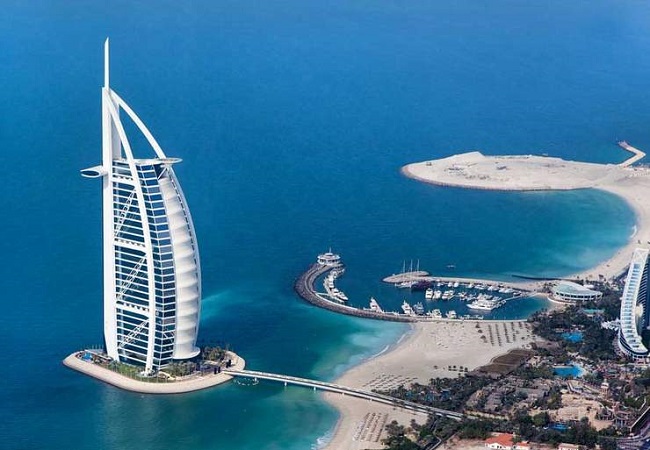The Sultanate of Oman can be found on the very southern tip of the Arabian Peninsula. Oman is a fascinating, yet little-visited, country full of wonderful sights and cities. Muscat, the capital, is where the vast majority of visitors end up, although it includes only a fraction of what makes Oman special.
Top 10 Places to Visit in United Arab Emirates
Put Oman on your list if you get a kick out of arid scenery, stunning mountain ranges, historic forts, and warm beaches any time of the year. A rundown of the top tourist attractions in Oman:

1. Misfat al Abryeen
Oman’s major towns can have a futuristic vibe, while tiny villages like Misfat al Abryeen preserve the country’s authentic character. The stone buildings in this mountain community range in colour from orange to brown, making it look more like an Italian mountain village than the Arabian Peninsula.
Nonetheless, Misfat al Abryeen is a stunning illustration of Oman’s mountain culture. There is a winding path up the mountain where you can stop and take in the views of the buildings, banana trees, and verdant landscape. Misfat al Abryeen and the irrigated fields and dams in the area can be viewed from atop a tower that overlooks the settlement.
2. Masirah Island
Masirah Island is just off the coast of Oman and offers visitors a one-of-a-kind opportunity to soak up some rays, explore some wildlife, and learn about some local history. Although the Omani air station on Masirah Island is large, the island’s settlements are little. It means you should expect to find fewer people and more isolated areas.
You can get to and from the mainland on a regular basis via ferry. Popular activities on Masirah Island include swimming, exploring the many shipwrecks just offshore, and observing the annual influx of more than 30,000 hatchling turtles.
3. Bahla
Bahla, in northern Oman, is another fantastic travel location in the country. Bahla is a watering hole in the desert where people have been pausing for ages. Bahla is about 25 miles (40 kilometres) from Nizwa, and it too features a magnificent and ancient fort.
The Banu Nebhan tribe dominated the area around the Bahla Fort in the 13th century. The city walls of Bahla are about seven kilometres in length and are composed of adobe, and can be seen in addition to the fort. Bahla is famous for its broad variety of handcrafted ceramics, which makes the city a great place to shop for gifts.
4. Salalah
Salalah, located in southern Oman, is sometimes referred to as the “second city” to Muscat. Salalah is pivotal now since it is the birthplace of Sultan Qaboos, the current ruler of Oman. The spectacular Qaboos Palace and the older architecture of the Haffa in Salalah’s Old Town are two highlights of any trip there.
Visit the Al Baleed Archaeological Site to take an even deeper dive into the past. Pick up some frankincense at the Haffa souk as a memento of your visit to Salalah, which is famous for its frankincense trade.
The coastal area near Salalah becomes a verdant oasis with seasonal waterfalls and streams thanks to the incessant rain brought by monsoon clouds from India from June to August.
5. Jebel Akhdar
Jebel Akhdar, located in the Al Hajar Mountains, is also known as Green Mountain. Don’t be misled by the name, and know that you won’t be seeing a conventional mountain peak. The highest peak in all of Oman is located in the Jebel Akhdar region, which is mostly composed of limestone.
The elevation allows for cooler temperatures and more agricultural growth than in the desert below, but it does not support a forest-covered landscape. You can now walk safely across the area’s stunning terraces and past fruiting trees. Although hiking in Oman’s deserts may not sound enticing, it is the ideal leisure in Jebel Akhdar.
6. Ras al Jinz
Ras al Jinz, near the very tip of Oman, is a protected area for the sea turtles that live in the Indian Ocean. There are turtle nests all around the beach, and if you go between May and October, you may observe the hatchlings make their way to the water.
While the turtle reserve may be seen as a day excursion from Muscat, most guests choose to stay the night at the resort so they can enjoy the Turtle Visitor Center and Museum as well.
7. Musandam Fjords
The United Arab Emirates separates Oman’s Musandam Peninsula in the north from the rest of the country. Mountain villages and coastal towns have long been the traditional homes of the people in this sparsely populated area. The Musandam Fjords, located to the north, are an absolutely breathtaking sight.
Musandam Fjords features include scuba diving, dolphin-watching from a traditional Omani boat (Dhow), and exploring the rocky coastlines and towering peaks from the water. Due to its low population density and rich wildlife, Oman’s Musandam Peninsula is highly recommended for ecotourists.
8. Wahiba Sands
The Wahiba Sands are a massive expanse of desert in the heart of Oman. The Bedu people call this region home, and it attracts many tourists looking to experience genuine, old-school Oman.
Join a tour that includes camel riding and desert camping to get a taste of the nomadic lifestyle of the Wahiba Sands. Many excursions of the Wahiba Sands start at the city of Ibra because it is the main entry point to the desert.
9. Nizwa
During Oman’s golden age in the sixth and seventh centuries, Nizwa was the country’s capital. The magnificent fortifications of this city were constructed in the 17th century under the supervision of Sultan Bin Saif Al Ya’ribi.
Certain sections of the fort, however, have been dated back to the ninth century. The massive cylindrical tower of Nizwa fort is the attraction. The fort’s defences are just as unique, with honey traps and oddly shaped windows for firing on attackers.
The museum inside the fort depicts daily life in Oman during the 17th century. Nizwa is home to a unique goat market that takes place twice weekly in the city centre, and the souk, or outdoor market, is another must-see while in town.
10. Muscat
Muscat is the most popular destination in Oman. There is something for everyone in this city, as it is home to forts, palaces, museums, and markets. The Qasr Al Alam Royal Palace is not open to the public, however it may be seen up close from the port.
Al Jalali and Al Mirani are twin forts that have been transformed into museums and stand vigil over the palace. The stunning Sultan Qaboos Great Mosque is open to visitors of all faiths every morning. Visitors can marvel at the massive crystal chandelier, marble wall panels, and the world’s second-largest Persian carpet.

























